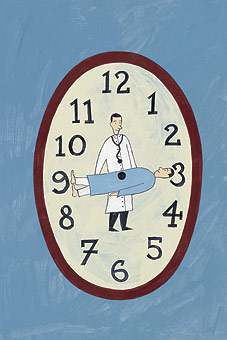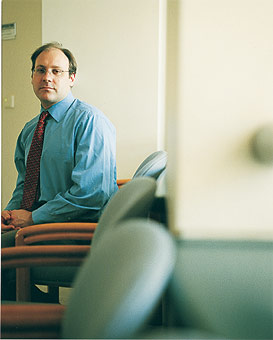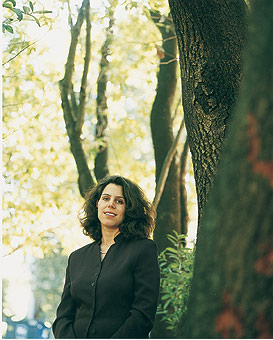New rules limiting residents’ work hours are driving
culture change — for better or worse
 |
|
|
|
By Ruthann Richter
Illustration by Jeffrey Fisher
Photographs by Leslie Williamson
![]() SIDEBAR 1: What the new rules say: Breaking them places accreditation
at risk
SIDEBAR 1: What the new rules say: Breaking them places accreditation
at risk
![]() SIDEBAR 2: Tired truth: Studies show residents are sleepy while they work
SIDEBAR 2: Tired truth: Studies show residents are sleepy while they work
Senior medicine resident Richard Lee, MD, is approaching the limit on his work hours and has missed the usual 1 p.m. sign-out meeting to hand off his patients. It’s no surprise; he’s a dedicated doctor, says chief resident Lucy Langer, MD. But in these days of regulated resident work hours, dedication has its limits — 80 hours a week, to be precise.
Langer goes to retrieve Lee from the coronary care unit, where he’s still chewing over the complex case of a patient he admitted the night before. The patient is a man in his 70s with a history of serious heart problems who’s on the brink of kidney failure. Lee and intern Vivian Tsai, MD, spent a few hours trying unsuccessfully to feed a central line from the man’s neck to his heart for tests to determine what’s wrong.
Lee is having trouble breaking away. He says he’s “still going strong” after 30 hours on duty. But under a nine-month-old mandate of the council that accredits post-MD medical training within the United States, unless he leaves the hospital he jeopardizes his residency program’s certification status.
“Nine months ago, I could have seen things through,” Lee says as he prepares to hand off the patient to Tsai. “If you get attached to your patients, you wonder about them. How did the tests go? How are they doing? Now, you have to leave it to someone else.”
The Accreditation Council for Graduate Medical Education’s move to limit residents’ hours evolved out of a growing concern for patient safety and a desire to make medical training more humane. The rules, instituted July 1, 2003, originated in 1984 with the celebrated Libby Zion case in New York, in which a patient’s death was attributed to resident error and fatigue. A 1999 landmark Institute of Medicine report on the widespread problem of medical errors gave further impetus to the regulations, although the report didn’t specifically address the issue of resident hours.
Some residents are grateful for the new rules. Yet many faculty and residents question whether they will really lead to fewer mistakes and better patient care. In fact, some believe the rules have created more opportunity for error, as residents who once spent prolonged periods with patients are now handing them off to another clinical team. In the process, critical details can fall through the cracks. Many also worry that the new work hours are creating a “shift mentality” among the nation’s future doctors, interfering with continuity of care and the patient-doctor bond — highly cherished values in medicine.
“You work your hours and you have to be willing to walk away,” says Bruce Reitz, MD, the Norman E. Shumway Professor in Cardiovascular Surgery and chair of cardiothoracic surgery. “What we’ve learned is the handoff is crucial. The person you’re handing off to has to have the same commitment to the patient. We rely on verbal communication. There’s always the possibility of misinterpretation or forgetting something. It’s a concern. We’re struggling with it.”
Hospital administrators are struggling too. The new regulations affect more than 500 residents at Stanford and Packard Children’s Hospital, who traditionally have worked through the nights to provide 24-hour coverage for patients. If, for instance, a patient has to be admitted at night, it is typically the resident on call who does the job.
With residents now working reduced hours, the cost of providing care has increased significantly, says Larry Shuer, MD, chief of staff at Stanford Hospital and professor of neurosurgery. For example, the cardiothoracic surgery department has spent $350,000 to hire two new fellows and two physician’s assistants to fill the gap, Reitz says. Other departments have either added staff or expanded the night float to fill the gap, Reitz says.
 |
|
Mark Koransky, MD, chief resident, general surgery. |
|
Residents themselves have given the new regulations mixed reviews. Some, like Mark Koransky, MD, chief resident in general surgery, believe the new work hour limits were long overdue. Surgery training can be grueling, with residents regularly putting in 120-hour work weeks, he notes.
Koransky recalls one particularly difficult shift when after a night of dealing with trauma patients, he encountered the case of a 20-year-old woman with a shattered spleen. The surgery had promised to be somewhat tricky but Koransky nonetheless had deftly removed the damaged organ and saved the woman’s life. The experience had left him utterly drained, though buoyant with a sense of accomplishment. Exhausted after 36 hours on the job, he was preparing to head out the door when another trauma patient — an 11-year-old bicyclist struck by a car — came rolling in.
“I was so depressed when that trauma patient came in,” Koransky recalls. “I just couldn’t generate the energy to handle it. That was the main problem with the old hours. You can’t keep doing that.”
Similarly, residents in pediatrics were hard-pressed to keep up the demands of their training regimens, which typically involved more than 100 hours a week of caring for very sick children, says Ted Sectish, MD, director of the residency training program in pediatrics and assistant professor of pediatrics. By the time the residents had finished their three years of training “they were burned out. They were incapable of committing to jobs after they left here. They wanted a break,” Sectish says.
Under the new work hours, he says, residents are more alert and better able to absorb what they learn.
“I think the new regulations provide residents with greater motivation to learn,” Sectish says. “I think they read more. They sure have the energy to do more things, such as advocacy and research.”
Still, he wonders if they’re getting the full range of exposure that they need and says the time may come when pediatric residency may stretch out to four years, rather than three.
Yale Popowich, MD, chief resident in general surgery, says he doesn’t believe residents are being short-changed in their education just because they’re spending less time at work.
“When you give interns time off, they work harder when they’re here,” he says. “It’s a long residency, and they’ll see everything they need to see by the time they’re finished.”
But are residents doing a better job and committing fewer errors because they’re alert? Are patients really better off?
The answer remains to be seen, although some say they’re doubtful patients are benefiting from the change. Continuity of care has suffered, and more frequent handoffs mean there are more chances for mistakes, some say.
Yuen So, MD, director of the residency training program in neurology, notes that the first 24 hours in a patient’s hospital experience are the most intense, when doctors do workups to help diagnose the patient’s condition and set a course for treatment. In the past, the resident on call at night would admit the patient and see the full process through until 5 p.m. the next day. Now, the resident leaves midway, putting the patient in the hands of another clinician.
“The person who admitted the patient is the person who knows the patient best, and that person can’t stay beyond noon or 1 p.m. That creates discontinuity in patient care and forces us to deal with that,” says So, an associate professor of neurology. He says he believes that every time a patient is transferred to a new clinician “there’s probably a slight drop in the quality of care.”
Moreover, under the new system in neurology, the departing resident passes his patients on to an intern who’s doing his or her rotation on the service.
“The disadvantage is that this is the least experienced doctor in the system, and it’s not someone with specific training in neurology. So it’s not a perfect system,” So says, though he notes that the intern always has backup from the senior resident and the attending.
More handoffs: pros and cons
The Department of Medicine — Stanford Hospital’s largest department, with 92 residents — is also struggling with how best to hand off patients without compromising care. One way it aims to do that is by developing a team approach to care, integrating all health-care professionals, including nurses, social workers and case managers, says Kelley Skeff, MD, PhD, the George DeForest Barnett Professor in Medicine and director of the medicine residency program.
“We have to ensure that in transferring patients we aren’t creating more errors, and some studies have raised that concern,” Skeff says. He cites one 1994 study by researchers at the Brigham and Women’s Hospital in Boston who found patients were more likely to suffer unexpected, preventable complications when they were being managed by residents from another team.
On the other hand, though handoffs have their risks, they also present opportunities, says patient safety researcher Steve Howard, MD, staff anesthesiologist at the VA Palo Alto Health Care System and associate professor of anesthesia. “What if the admitting team was doing something ‘wrong’ and otherwise harmful to the patient?” he says; the incoming team might uncover and rectify the problem. Moreover, residents who are rested and alert are more apt to do a better job of communicating to the new team than those clouded by fatigue, he says.
 |
|
Lucy Langer, MD, chief resident, medicine department |
|
Still, Langer, the chief resident in medicine, says she worries that the team transfers could contribute to a decline in care, despite the many checks in place.
“If anything, I think patient care might be worse off, especially in this transition phase. I think the handoffs are one place where errors are more likely to happen. There are more handoffs, more people working staggered times and the safety nets that are in place when there is a cohesive team are not as tightly woven,” she says.
Out of sight, but not out of mind
Some residents also complain that the new regulations conflict with the core values they embraced in medical school — i.e. the importance of commitment to patients and the ongoing doctor-patient relationship.
“I used to tell my patients ‘I’m going to be here all day and all night, and I’ll be here to help you.’ That is reassuring to a patient, as this can be the worst day of his life,” says third-year medicine resident Beth Gentilesco, MD. “The residents have a strong sense of responsibility and are reluctant to leave patients they’ve just admitted.”
Senior medicine resident Lee, who left his heart patient behind with tests still pending, says he routinely checks in by phone with his teammate Tsai in the evening to get updates on the status of their patients. In the case of the heart patient, for instance, the afternoon’s tests confirmed what the two had suspected — that his heart problems were contributing to kidney failure and he was in need of dialysis, Lee says. The man continued to improve over time and was discharged from the hospital several weeks later.
Lee says that with the new system of resident hours, communication is all the more critical.
Though some residents, like Lee, remain committed to their patients, Shuer, Stanford Hospital’s chief of staff, says he worries the new regulations will lead to a health-care system staffed by physicians with a “punch-clock” mentality.
“I wonder if the present crop of residents are going to have different expectations of how they run their practices,” asks Shuer. “We say, ‘Look, you are there attending to your patients, and sometimes that even comes at the expense of your family.’ There are many changes in medicine now that are reducing the connection, or bonding, with the patient. So I just hope this doesn’t make medicine more impersonal.”
How will the restrictions on resident work hours alter the quality of patient care and resident education? Among Stanford’s faculty and residents, no consensus exists.
Time will tell. SM
What the new rules say: Breaking them places
accreditation at risk
The nation’s 7,800 residency programs must comply with new regulations instituted July 1, 2003, by the agency that accredits post-MD medical training within the United States — the Accreditation Council for Graduate Medical Education.
The new rules specify that:
• Residents cannot work more than 80 hours a week, averaged over a month.
• Residents cannot work more than 24 hours straight, although they may remain on duty an extra six hours to transfer patients or participate in educational activities.
• Residents must have one day a week free from all clinical and educational responsibilities.
• Residents cannot be scheduled for in-house call more than once every three nights.
The accrediting group is monitoring compliance through confidential resident surveys, site visits and assessments by review committees. Programs that fail to comply risk losing their accreditation, which would effectively shut them down. The group is considering further refinements to the regulations, based on data it collects during the accreditation process and feedback it receives from the review committees, according to an ACGME representative.
The council has shown that it means business. After a complaint from an intern at Johns Hopkins School of Medicine, the accrediting agency announced last year it was withdrawing certification for the school’s internal medicine residency program. Johns Hopkins appealed, and the program since has been granted full accreditation. — Ruthann Richter
The Web offers news and discussion about resident work hours. Among the resources:
• The ACGME’s Web site: acgme.org
• American Medical News, published by the American Medical Association: amednews.com, search term,“duty hours”
• The Association of American Medical Colleges: aamc.org, click on “newsroom” and search for the term “duty hours.” SM
Tired truths: Studies show residents are sleepy while they work
Ted Sectish, MD, tells the story of a resident in pediatrics who, after 37 hours on call, slumped over the wheel while driving home and rear-ended a car at a stoplight. After pausing to exchange information with the other driver, the resident climbed back into her car, coasted to a stop at the next light and nodded off again in another rear-end collision, says Sectish, director of Stanford’s pediatrics residency program and assistant professor of pediatrics.
Such stories, which fill medical lore and literature, are no surprise to Steve Howard, MD, a staff anesthesiologist at the VA Palo Alto Health Care System who has studied the issue of fatigue among anesthesiologists, including sleepy residents at Stanford.
Based on his studies and others, Howard says he doesn’t believe the new regulations limiting residents’ work hours go far enough. “Health care is truly a broken system in regards to the demands being placed on its workers,” he says.
He notes that airline pilots, nuclear plant workers and others in jobs that involve life-and-death situations are subject to far greater restrictions on their work schedules.
“If you look to other hazardous industries, they’ve not allowed extremely long hours on the job. That’s because we know that if you’re not optimally alert, you’re prone to more mistakes,” says Howard, an associate professor of anesthesia.
Howard and his colleagues at the VA have focused on residents in anesthesiology, who must be ever-vigilant to keep up with minute-by-minute changes in a patient’s status. In one 1996 study, the researchers measured levels of daytime sleepiness among 11 Stanford residents on a normal workday, after being on 24-hour call in the hospital, and on a day when they were fully rested.
They found that even in the course of their normal routines — i.e. working 10-hour days five days a week — the trainees were chronically sleep-deprived, with daytime sleepiness levels similar to or higher than those of narcoleptics and sleep apnea patients.
Moreover, the study, published in October 2002 in the journal Academic Medicine, revealed that trainees perceived themselves as alert even when physiologic measures indicated they were truly tired.
“Perception is a big issue,” Howard says. “If we’re not very good at perceiving our problems, then we’re going to be more prone to doing something that could lead to mistakes because we don’t know better.”
In a more recent study, Howard collaborated with David Gaba, MD, professor of anesthesia, and others in observing anesthesia residents as they carried out specific anesthesia tasks in a patient simulator when fatigued and when fully rested. The study included 12 residents who were asked to administer anesthesia in a simulated environment after they had been awake for 25 hours and again during a normal, workday shift.
As expected, when sleep deprived, residents didn’t do as well on tests for alertness, memory and mood. The sleep-deprived group also made more errors and some actually nodded off on the job. The results were published in June 2003 in the journal Anesthesiology.
Howard says it’s difficult to show a direct correlation between fatigue and work performance in a clinical setting, though this link has been well-established in other industries. He and Gaba say the burden of proof in medicine is misplaced.
“In every other industry we think that being tired is bad and we’re just not going to allow it,” Gaba says. “In medicine, you have to prove you’re killing people before we do something about it.” — Ruthann Richter
Comments? Contact Stanford Medicine at

